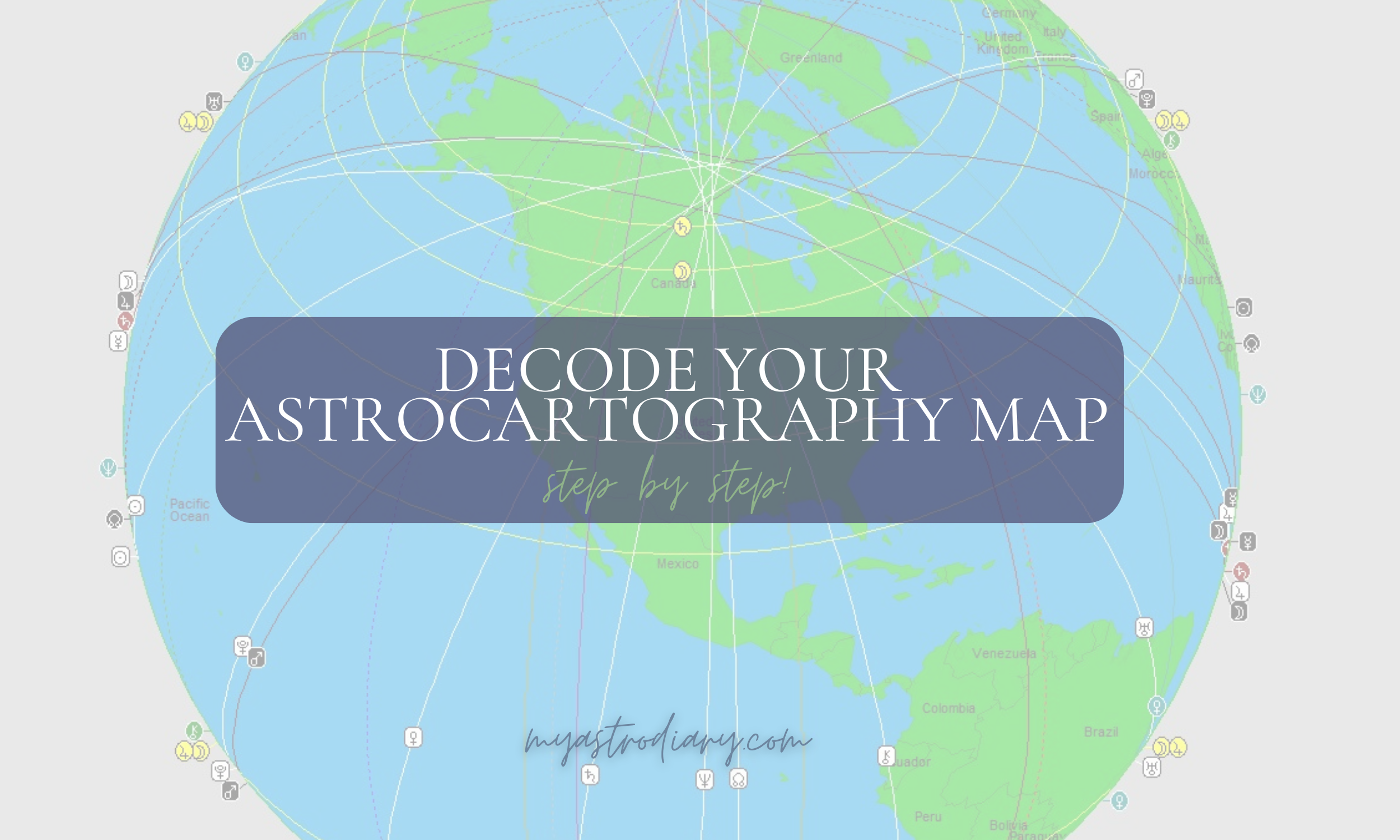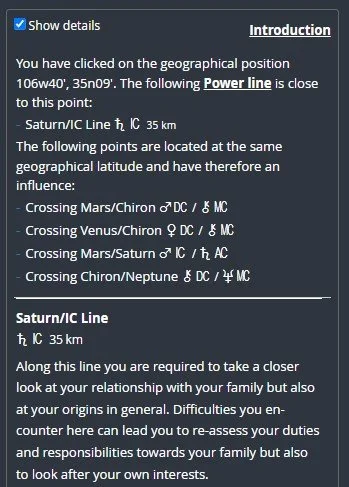How to read your astrocartography chart as a beginner
Learning how to read an astrocartography map can feel overwhelming at first, especially when faced with a colorful web of lines and symbols stretching across the globe. But it doesn’t have to be! With a little guidance, you’ll see that your astrocartography chart is more than just a visual representation; it’s a powerful tool for self-discovery and intentional living. Let’s go step by step on how you can approach your astrocartography map.
STEP #0: understand that relocation charts equals astrocartography
To build a stable foundation for understanding how to read your astrocartography map, it’s necessary to recognize from the very beginning that your map is actually made up of relocation charts. Each location on the map carries its own unique energy, even in areas where no lines cross directly! It might feel a little confusing now, but keep this in mind: you’ll have an “aha!” moment later when it all clicks into place!
STEP #1: learn astrology basics
If you have basic knowledge of astrology already (and when I say basic, I don’t mean Sun sign astrology), I mean you know how to decipher symbols on a chart, basic meanings behind signs, planets, how the house system works and with it the ASC, DC, IC, MC lines, then you are definitely ready to learn to decipher your astrocartography map with way more ease, as you know the basics of a whole language. :)
If you don’t, I highly suggest you first learn the symbolism, at least behind each planet. I explained here why this is important, in a guide which is more in-depth than this one. The best way to memorize them is to draw each by hand and to hang them above your workspace or anywhere you spend a lot of time during the day. If writing doesn’t resonate or you are not able, feel free to save my cheat sheet so you can print it out and hang it:
Once you understood this in depth, you are now ready to explore your astrocartography map!
STEP #2: pull your astrocartography map
It’s time to pull up the chart! As a complete beginner, it’s ideal for you to run your first chart via astro.com (Horoscope AstroClick Travel); it is generally the best map when it comes to clarity due to its zoom-in option on a live map like Google Maps. A professional software would just push the overwhelm further! So don’t worry if you don’t have one from the very beginning.
Once you pull up your chart after entering precise birth data (down to the minute), you need to understand what we said in step #0: your astrocartography map is an extension of your own birth chart. That’s why I highly suggest you open your birth chart (run here) + relocation chart (run here) in the tabs besides your map, too!
In this freshly opened astrocartography map, we can see the red cross as the place of birth. You can see the blue line with the AC (Uranus) on the west side, and the yellow DC line (Sun) on the east. Even though this random person isn’t directly born on these lines, they have an impact! We can exactly see this in their birth chart as well:
See the same symbol as on the astrocartography map (blue one), being close to the ASC line (to be precise, 3 degrees apart from each other), and the same with the Sun on the opposite, DC line? If they were exact, they would be on the exact degree of the Ascendant and Descendant.
That means that the person is exactly living on these lines. So you also learned now that you don’t need to be exactly on the line to feel its impact. This is why measuring the distance is important, and you can measure by clicking directly on the opened astro map! It will usually show up to 155 miles of measurement and not above it, meaning that Astro Click is focused on the strongest impact of lines. But what happens when you want to explore beyond the place of birth?
STEP #3: understanding your relocation chart
Let’s say, our fellow from the chart above decides to move from Charlotte, NC, where he or she has lived their whole life, all the way to Albuquerque, NM:
See the difference between the birth chart (left) and relocation chart (right)? Keep in mind how the Ascendant in Charlotte (birth location) is on 13 degrees of Aquarius, while it’s on 14 degrees in Capricorn in Albuquerque. This ASC change shifts the charts’ houses and positions of the planets.
That’s basically how this person moves to its Saturn IC line (circled on the second pic at the bottom of the chart. Now, below, you can see the Saturn IC line going 20 miles west from Albuquerque! That’s the magic of relocation & astrocartography in general. Now you know the ultimate basics, and I hope you have the “aha” moment I mentioned at the beginning. :)
STEP #4: learning the lines isn’t all black and white
Once you begin to learn the meanings behind the lines in more depth, make sure from the very beginning that it’s not all this or that. You are not doomed if you live on a Pluto or a Saturn line, and it’s not going to be all roses just by relocating to a Venus or a Jupiter line. This is where analyzing your birth chart aspects comes into play. For example, if you have a Venus in Virgo with, let’s say, 3 squares to other planets, and you are relocating to your Venus MC line with high hopes when it comes to your career life…
You can end up quite disappointed with an extra life lesson going there, which matches more the themes of squares and personal growth, plus it depends on what paran lines are the place impacted by. Within a professional software like SolarFire, you can visually see paran lines, while on astro.com, you can see them by clicking on a certain place, and then on the top right, clicking on show details:
You can see them as ‘crossings’ here. In astrocartography, paran lines (or latitude lines) refer to the planetary alignments that occur when planets rise, set, culminate, or anti-culminate simultaneously with a location’s horizon, affecting that place horizontally based on its longitude and latitude, which means that they add an ‘extra flavor’ to the story with their impact.
From my personal experience, feeling paran lines usually come from spending a longer period of time in a certain location, rather than instantly, and come up as eerily accurate! So it’s important to pay attention to them as well, especially when you are deciding to permanently relocate to a new place, or be in one place for a longer period.
Also, if you are deciding to permanently relocate, keep in mind your local space map, too. You can run a local space chart here. Keep in mind that the approach is different from astrocartography.
STEP #5: timing matters, too
Even though this step isn’t usually where beginners start, it’s still helpful to keep in mind early on. You may have heard of Cyclocartography — a more advanced astrocartography technique that explores how planetary cycles influence certain places over time. It combines your personal transits and progressions with location, showing how different areas might light up with new energy or important life themes as the planets continue to move and interact with your chart.
It’s like checking the weather forecast for your soul; not just once, but across time.
A good example of this is Saturn lines. Let’s say you are 18-20 years old and just moving to your college town! But in your college town, you are actually moving to a certain Saturn line (CCG, locational, or major). Your college time can feel pretty isolating, especially at such an early age, yet it can teach you resilience, life-long lessons, responsibility, and seriousness. Yet let’s agree… Saturn line and college in one sentence sounds utterly boring.
While in a more mature age, let’s say after your second Saturn return passes around the age of 60, Saturn lines can be highly beneficial, especially if you have long-term goals to fulfill on your mind, as Saturn rewards consistency and maturity together. I hope this also gives you a bigger picture of how lines aren’t all black and white + how timing affects different life stages!
Congratulations, you learned the basics of astrocartography!
Understanding how to read an astrocartography map is an exciting first step into discovering how different locations can influence your energy and life path. With this diary entry and the cheat sheets within it, you should have a good grasp on interpreting the lines and symbols on your astrocartography chart, helping you explore the powerful connections between your birth chart and the places you live or are planning to visit or relocate. Here’s a summary of what you need:
Date of birth (day, month, year)
Exact time of birth (down to the minute, if possible)
Place of birth (city, country, and ideally the exact coordinates)
A free website to run your chart, like AstroClick Travel by astro.com
a free website to run your birth chart, like Astro Seek
a free website to run your relocation chart, like this one on Astro Seek, once again
Basic knowledge of astrology (especially planets, signs, and houses, elementary meanings and symbolism) - feel free to save the pictures from above
Here is also the summary of the steps:
Understand that relocation charts equal astrocartography!!!
Learn astrology basics — broad meanings of planets, signs, and houses + symbolism
Pull your astrocartography map and explore
Begin understanding your relocation chart
Start learning about lines’ meanings and paran lines
Keep in mind cyclocartography (timing)
Happy exploring!
If you need further guidance in learning astrocartography, join my locational astrology learning hub
This ongoing hub is designed for slow, meaningful learning with space to digest each idea. When you need to take a break for a week (or three), it's totally fine here. The content waits for you, not the other way around. The structure allows for natural pauses to review, revisit, and absorb, so nothing feels rushed or crammed.
Good luck with interpretations & until the next diary entry,
xx Ang












